Create of Generate PDF file in UWP
20 Jan 202518 minutes to read
The Syncfusion® UWP PDF library is used to create, read, and edit PDF documents. This library also offers functionality to merge, split, stamp, forms, and secure PDF files.
To include the Syncfusion® UWP PDF library into your UWP application, please refer to the NuGet Package Required or Assemblies Required documentation.
Steps to create PDF document in UWP
Step 1: Create a new UWP application project.
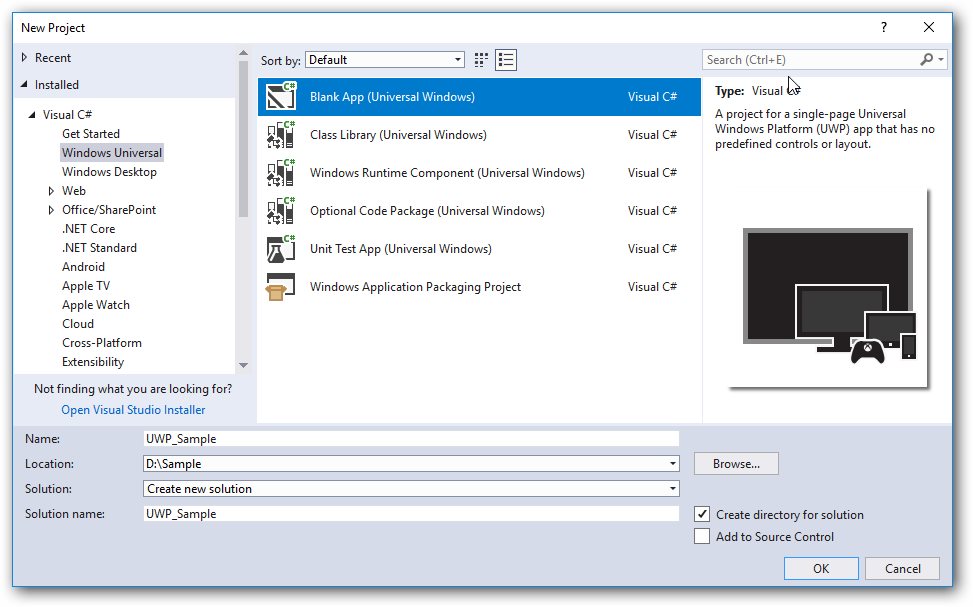
Step 2: Install the Syncfusion.Pdf.UWP NuGet package as reference to your UWP applications from NuGet.org.
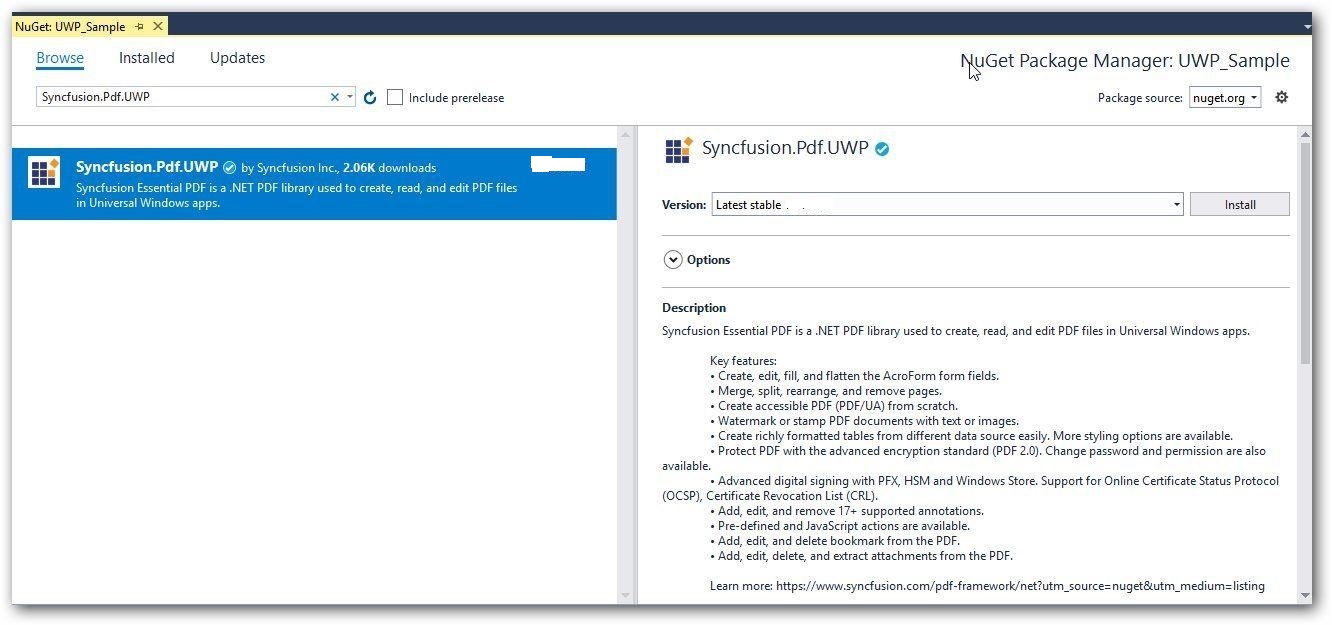
NOTE
Starting with v16.2.0.x, if you reference Syncfusion® assemblies from trial setup or from the NuGet feed, you also have to add “Syncfusion.Licensing” assembly reference and include a license key in your projects. Please refer to this link to know about registering Syncfusion® license key in your application to use our components.
Step 3: Create button in MainPage.Xaml page using below code example and create Button_Click event.
<Grid>
<Button Content="CreatePDF" HorizontalAlignment="Center" VerticalAlignment="Center" Width="150" Height="100" Click="Button_Click" />
</Grid>Step 4: Include the following namespaces in the MainPage.xaml.cs file.
using Syncfusion.Pdf;
using Syncfusion.Pdf.Graphics;
using System;
using System.Collections.Generic;
using System.Drawing;
using System.IO;
using Windows.Storage;
using Windows.Storage.Pickers;
using Windows.UI.Popups;
using Windows.UI.Xaml;
using Windows.UI.Xaml.Controls;Step 5: Include the following code example in the click event of the button in MainPage.xaml.cs file to create PDF document using the PdfDocument class. Then use the DrawString method of the PdfGraphics object to draw the text on the PDF page.
//Create a PDF document.
using (PdfDocument document = new PdfDocument())
{
//Add a page to the document.
PdfPage page = document.Pages.Add();
//Create PDF graphics for the page
PdfGraphics graphics = page.Graphics;
//Set the standard font.
PdfFont font = new PdfStandardFont(PdfFontFamily.Helvetica, 20);
//Draw the text.
graphics.DrawString("Hello World!!!", font, PdfBrushes.Black, new PointF(0, 0));
//Create memory stream.
MemoryStream ms = new MemoryStream();
//Open the document in browser after saving it.
document.Save(ms);
//Close the document.
document.Close(true);
Save(ms, "Sample.pdf");
}Step 6: Use the following helper method to save the stream as a physical file and open the file for viewing.
#region Helper Methods
public async void Save(Stream stream, string filename)
{
stream.Position = 0;
StorageFile stFile;
if (!(Windows.Foundation.Metadata.ApiInformation.IsTypePresent("Windows.Phone.UI.Input.HardwareButtons")))
{
FileSavePicker savePicker = new FileSavePicker();
savePicker.DefaultFileExtension = ".pdf";
savePicker.SuggestedFileName = "Sample";
savePicker.FileTypeChoices.Add("Adobe PDF Document", new List<string>() { ".pdf" });
stFile = await savePicker.PickSaveFileAsync();
}
else
{
StorageFolder local = Windows.Storage.ApplicationData.Current.LocalFolder;
stFile = await local.CreateFileAsync(filename, CreationCollisionOption.ReplaceExisting);
}
if (stFile != null)
{
Windows.Storage.Streams.IRandomAccessStream fileStream = await stFile.OpenAsync(FileAccessMode.ReadWrite);
Stream st = fileStream.AsStreamForWrite();
st.SetLength(0);
st.Write((stream as MemoryStream).ToArray(), 0, (int)stream.Length);
st.Flush();
st.Dispose();
fileStream.Dispose();
MessageDialog msgDialog = new MessageDialog("Do you want to view the Document?", "File created.");
UICommand yesCmd = new UICommand("Yes");
msgDialog.Commands.Add(yesCmd);
UICommand noCmd = new UICommand("No");
msgDialog.Commands.Add(noCmd);
IUICommand cmd = await msgDialog.ShowAsync();
if (cmd == yesCmd)
{
//Launch the retrieved file.
bool success = await Windows.System.Launcher.LaunchFileAsync(stFile);
}
}
}
#endregionYou can download a complete working sample from GitHub.
By executing the program, you will get the PDF document as follows.

Creating a PDF document with image
Load image stream from the local files on disk and draw the images through the DrawImage method of the PdfGraphics class. The following code example shows how to create a PDF document with an image.
//Create a new PDF document.
PdfDocument doc = new PdfDocument();
//Add a page to the document.
PdfPage page = doc.Pages.Add();
//Create PDF graphics for the page.
PdfGraphics graphics = page.Graphics;
//Load the image as stream.
Stream imageStream = typeof(MainPage).GetTypeInfo().Assembly.GetManifestResourceStream("Adventure Cycles.png");
//Load the image from the disk.
PdfBitmap image = new PdfBitmap(imageStream);
//Draw the image.
graphics.DrawImage(image, 0, 0);
//Create memory stream.
MemoryStream ms = new MemoryStream();
//Open the document in browser after saving it.
doc.Save(ms);
//Close the document.
doc.Close(true);
Save(ms, "Sample.pdf");By executing the program, you will get the PDF document as follows.
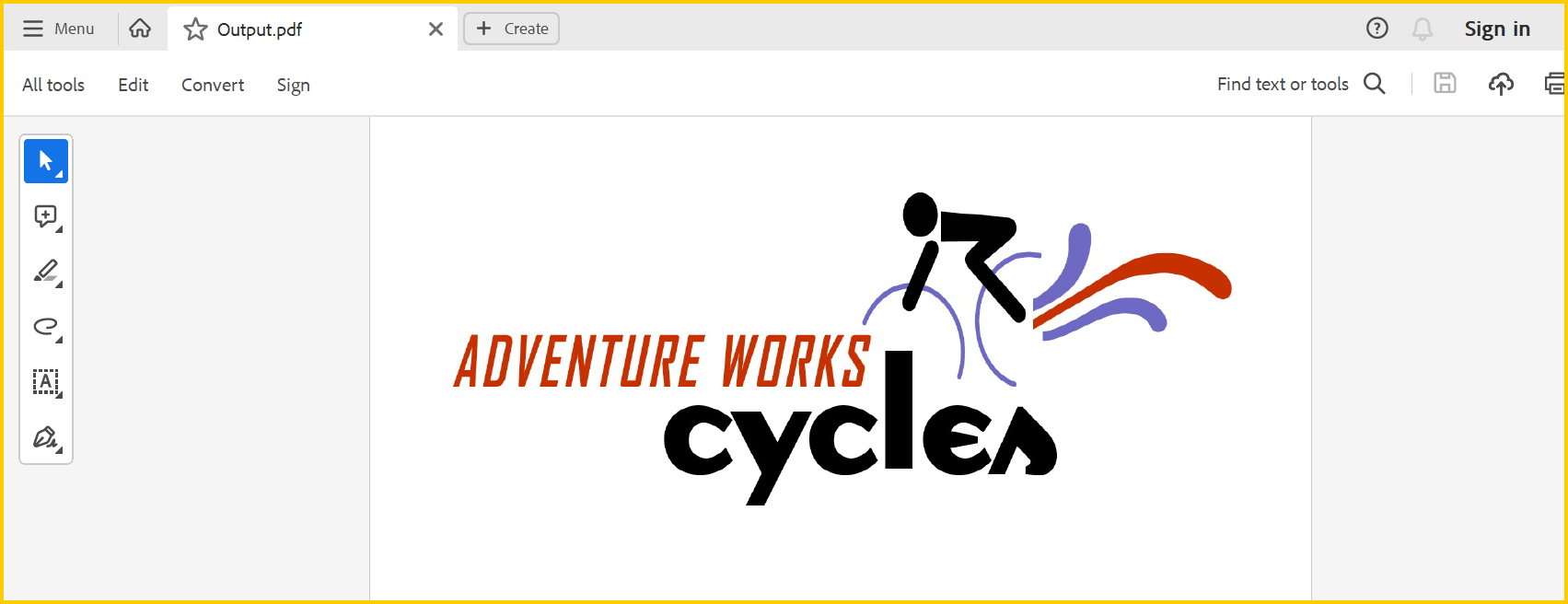
Creating a PDF document with table
//Create a new PDF document.
PdfDocument doc = new PdfDocument();
//Add a page.
PdfPage page = doc.Pages.Add();
//Create a PdfGrid.
PdfGrid pdfGrid = new PdfGrid();
//Add values to list
List<object> data = new List<object>();
Object row1 = new { ID = "E01", Name = "Clay" };
Object row2 = new { ID = "E02", Name = "Thomas" };
Object row3 = new { ID = "E03", Name = "Andrew" };
Object row4 = new { ID = "E04", Name = "Paul" };
Object row5 = new { ID = "E05", Name = "Gray" };
data.Add(row1);
data.Add(row2);
data.Add(row3);
data.Add(row4);
data.Add(row5);
//Add list to IEnumerable
IEnumerable<object> dataTable = data;
//Assign data source.
pdfGrid.DataSource = dataTable;
//Apply built-in table style
pdfGrid.ApplyBuiltinStyle(PdfGridBuiltinStyle.GridTable4Accent1);
//Draw grid to the page of PDF document.
pdfGrid.Draw(page, new PointF(10, 10));
//Save the PDF document to stream.
MemoryStream stream = new MemoryStream();
await doc.SaveAsync(stream);
//Close the document.
doc.Close(true);
//Save the stream as PDF document file in local machine. Refer to PDF/UWP section for respected code samples.
Save(stream, "Output.pdf");You can download a complete working sample from GitHub.
By executing the program, you will get the PDF document as follows.
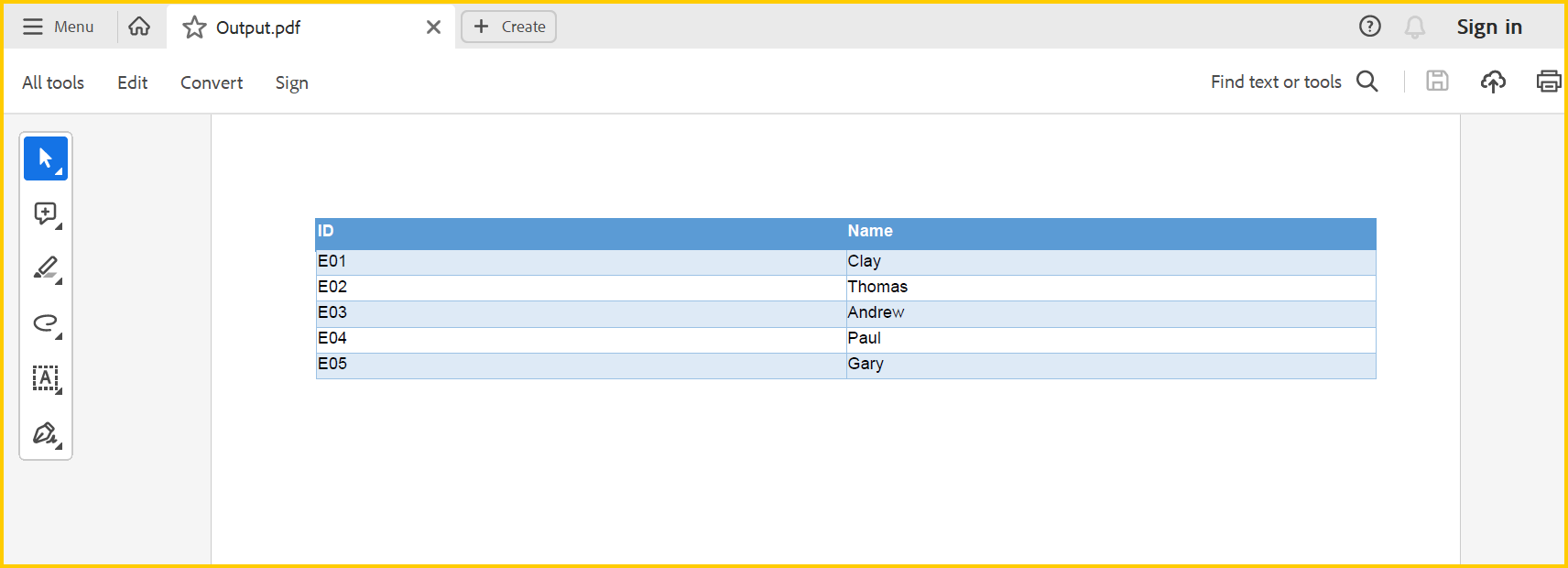
Creating a simple PDF document with basic elements
The PdfDocument object represents an entire PDF document that is being created. The following code example shows how to create a PDF document and add a PdfPage to it along with the PdfPageSettings.
//Creates a new PDF document.
PdfDocument document = new PdfDocument();
//Adds page settings.
document.PageSettings.Orientation = PdfPageOrientation.Landscape;
document.PageSettings.Margins.All = 50;
//Adds a page to the document.
PdfPage page = document.Pages.Add();
PdfGraphics graphics = page.Graphics;- Essential® PDF has APIs similar to the .NET GDI plus which helps to draw elements to the PDF page just like 2D drawing in .NET.
- Unlike System.Drawing APIs all the units are measured in point instead of pixel.
- In PDF, all the elements are placed in absolute positions and has the possibility for content overlapping if misplaced.
- Essential® PDF provides the rendered bounds for each and every elements added through PdfLayoutResult objects. This can be used to add successive elements and prevent content overlap.
The following code example explains how to add an image from disk to a PDF document, by providing the rectangle coordinates.
//Load the image as stream.
Stream imageStream = typeof(MainPage).GetTypeInfo().Assembly.GetManifestResourceStream("Sample.Assets.Data.AdventureCycle.jpg");
//Load the image from the stream.
PdfImage image = PdfImage.FromStream(imageStream);
RectangleF bounds = new RectangleF(176, 0, 390, 130);
//Draws the image to the PDF page.
page.Graphics.DrawImage(image, bounds);The following methods can be used to add text to a PDF document.
- DrawString() method of the PdfGraphics
- PdfTextElement class.
The PdfTextElement provides the layout result of the added text by using the location of the next element that decides to prevent content overlapping. This is not available in the DrawString method.
The following code example adds the necessary text such as address, invoice number and date to create a basic invoice application.
PdfBrush solidBrush = new PdfSolidBrush(new PdfColor(126, 151, 173));
bounds = new RectangleF(0, bounds.Bottom + 90, graphics.ClientSize.Width, 30);
//Draws a rectangle to place the heading in that region.
graphics.DrawRectangle(solidBrush, bounds);
//Creates a font for adding the heading in the page.
PdfFont subHeadingFont = new PdfStandardFont(PdfFontFamily.TimesRoman, 14);
//Creates a text element to add the invoice number.
PdfTextElement element = new PdfTextElement("INVOICE " + id.ToString(), subHeadingFont);
element.Brush = PdfBrushes.White;
//Draws the heading on the page.
PdfLayoutResult result = element.Draw(page, new PointF(10, bounds.Top + 8));
string currentDate = "DATE " + DateTime.Now.ToString("MM/dd/yyyy");
//Measures the width of the text to place it in the correct location.
SizeF textSize = subHeadingFont.MeasureString(currentDate);
PointF textPosition = new PointF(graphics.ClientSize.Width - textSize.Width - 10, result.Bounds.Y);
//Draws the date by using DrawString method.
graphics.DrawString(currentDate, subHeadingFont, element.Brush, textPosition);
PdfFont timesRoman = new PdfStandardFont(PdfFontFamily.TimesRoman, 10);
//Creates text elements to add the address and draw it to the page.
element = new PdfTextElement("BILL TO ", timesRoman);
element.Brush = new PdfSolidBrush(new PdfColor(126, 155, 203));
result = element.Draw(page, new PointF(10, result.Bounds.Bottom + 25));
PdfPen linePen = new PdfPen(new PdfColor(126, 151, 173), 0.70f);
PointF startPoint = new PointF(0, result.Bounds.Bottom + 3);
PointF endPoint = new PointF(graphics.ClientSize.Width, result.Bounds.Bottom + 3);
//Draws a line at the bottom of the address.
graphics.DrawLine(linePen, startPoint, endPoint);Essential® PDF provides two types of table models. The difference between both the table models can be referred from the link
Difference between PdfLightTable and PdfGrid
Since the invoice document requires only simple cell customizations, the given code example explains how to create a simple invoice table by using PdfGrid.
//Creates the datasource for the table.
DataTable invoiceDetails = GetProductDetailsAsDataTable();
//Creates a PDF grid.
PdfGrid grid = new PdfGrid();
//Adds the data source.
grid.DataSource = invoiceDetails;
//Creates the grid cell styles.
PdfGridCellStyle cellStyle = new PdfGridCellStyle();
cellStyle.Borders.All = PdfPens.White;
PdfGridRow header = grid.Headers[0];
//Creates the header style.
PdfGridCellStyle headerStyle = new PdfGridCellStyle();
headerStyle.Borders.All = new PdfPen(new PdfColor(126, 151, 173));
headerStyle.BackgroundBrush = new PdfSolidBrush(new PdfColor(126, 151, 173));
headerStyle.TextBrush = PdfBrushes.White;
headerStyle.Font = new PdfStandardFont(PdfFontFamily.TimesRoman, 14f, PdfFontStyle.Regular);
//Adds cell customizations.
for (int i = 0; i < header.Cells.Count; i++)
{
if (i == 0 || i == 1)
header.Cells[i].StringFormat = new PdfStringFormat(PdfTextAlignment.Left, PdfVerticalAlignment.Middle);
else
header.Cells[i].StringFormat = new PdfStringFormat(PdfTextAlignment.Right, PdfVerticalAlignment.Middle);
}
//Applies the header style.
header.ApplyStyle(headerStyle);
cellStyle.Borders.Bottom = new PdfPen(new PdfColor(217, 217, 217), 0.70f);
cellStyle.Font = new PdfStandardFont(PdfFontFamily.TimesRoman, 12f);
cellStyle.TextBrush = new PdfSolidBrush(new PdfColor(131, 130, 136));
//Creates the layout format for grid.
PdfGridLayoutFormat layoutFormat = new PdfGridLayoutFormat();
//Creates layout format settings to allow the table pagination.
layoutFormat.Layout = PdfLayoutType.Paginate;
//Draws the grid to the PDF page.
PdfGridLayoutResult gridResult = grid.Draw(page, new RectangleF(new PointF(0, result.Bounds.Bottom + 40), new SizeF(graphics.ClientSize.Width, graphics.ClientSize.Height - 100)), layoutFormat);The following code example shows how to save the invoice document to disk and dispose the PdfDocument object.
//Save the PDF document to stream.
MemoryStream stream = new MemoryStream();
await document.SaveAsync(stream);
//Close the document.
document.Close(true);
//Save the stream as PDF document file in local machine. Refer to PDF/UWP section for respected code samples.
Save(stream, "Sample.pdf");You can download a complete working sample from GitHub.
The following screenshot shows the invoice PDF document created by using Essential® PDF.

Filling forms
An interactive form sometimes referred to as an AcroForm, is a collection of fields for gathering information interactively from the user. A PDF document or existing PDF document contain any number of fields appearing in any combination of pages, all that make a single, globally interactive form spanning the entire document.
Essential® PDF allows you to create and manipulate existing form in a PDF document using the PdfForm class. The PdfLoadedFormFieldCollection class represents the entire field collection of the loaded form. To work with existing form documents, the following namespaces are required.
- Syncfusion.Pdf
- Syncfusion.Pdf.Parsing
The following guide shows how to fill out a sample PDF form.
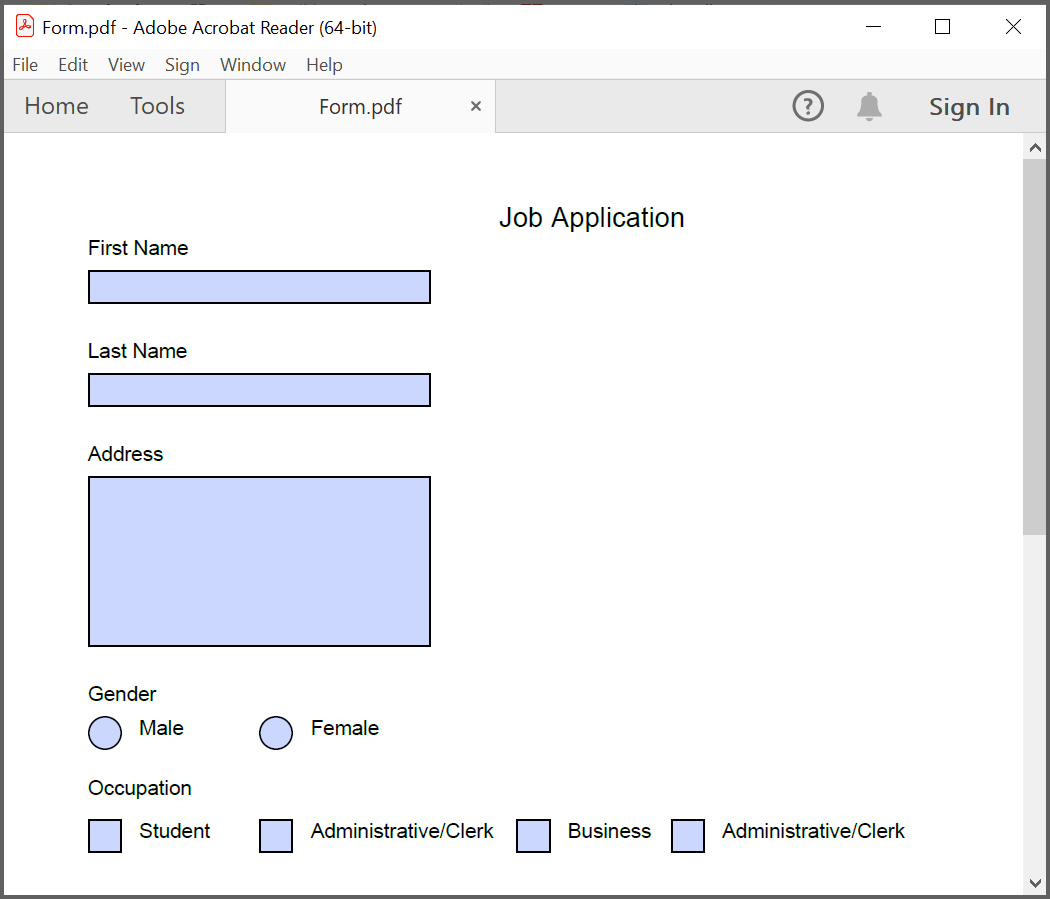
Essential® PDF allows you to fill the form fields by using PdfLoadedField class. You can get the form field either by using its field name or field index.
//Create the file open picker.
var picker = new FileOpenPicker();
picker.FileTypeFilter.Add(".pdf");
//Browse and chose the file.
StorageFile file = await picker.PickSingleFileAsync();
//Creates an empty PDF loaded document instance.
PdfLoadedDocument loadedDocument = new PdfLoadedDocument();
//Loads or opens an existing PDF document through Open method of PdfLoadedDocument class.
await loadedDocument.OpenAsync(file);
//Loads the form.
PdfLoadedForm form = loadedDocument.Form;
//Fills the textbox field by using index.
(form.Fields[0] as PdfLoadedTextBoxField).Text = "John";
//Fills the textbox fields by using field name.
(form.Fields["LastName"] as PdfLoadedTextBoxField).Text = "Doe";
(form.Fields["Address"] as PdfLoadedTextBoxField).Text = " John Doe \n 123 Main St \n Anytown, USA";
//Loads the radio button group.
PdfLoadedRadioButtonItemCollection radioButtonCollection = (form.Fields["Gender"] as PdfLoadedRadioButtonListField).Items;
//Checks the 'Male' option.
radioButtonCollection[0].Checked = true;
//Checks the 'business' checkbox field.
(form.Fields["Business"] as PdfLoadedCheckBoxField).Checked = true;
//Checks the 'retiree' checkbox field.
(form.Fields["Retiree"] as PdfLoadedCheckBoxField).Checked = true;
//Save the PDF document to stream.
MemoryStream stream = new MemoryStream();
await loadedDocument.SaveAsync(stream);
//Close the document.
loadedDocument.Close(true);
//Save the stream as PDF document file in local machine. Refer to PDF/UWP section for respected code samples.
Save(stream, "output.pdf");You can download a complete working sample from GitHub.
The filled form is shown in adobe reader application as follows.
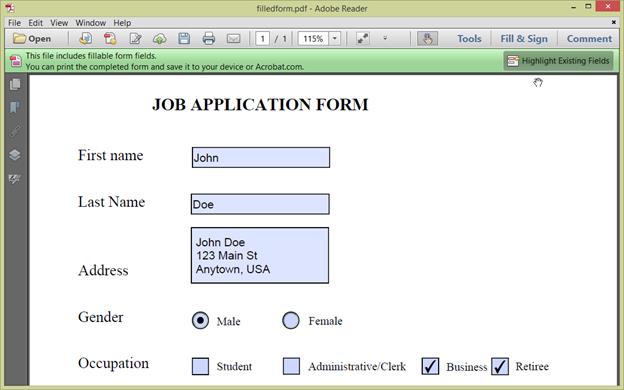
Click here to explore the rich set of Syncfusion® PDF library features.
An online sample link to create PDF document in ASP.NET Core.